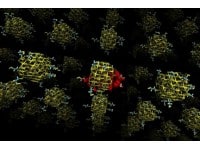
Quantum dots are semiconducting, nanoscale clusters that show electronic characteristics distinct from both bulk-scale materials and single molecules. Their special characteristics make quantum dots attractive for a broad range of potential applications, including photovoltaics and nanoscale transistors.
The size and shape of quantum dots impact electrical properties and can therefore be used to tune the dots (for example, for absorption/emission of desired wavelengths of light). In the case of photovoltaic cells, the performance of quantum dots has not lived up to theoretical potential, and it was expected that the reason had to do with the presence of dangling bonds at the dot surfaces. But new computational work from the lab of Jeffrey Grossman at MIT indicate that in the case of PbS quantum dots, the reason is stoichiometry. The work is published in Physical Review Letters (abstract) and is described in an article in Energy Harvesting Journal (selected excerpts shown):
In bulk quantities of lead sulfide, the material used for the quantum dots in this study, the ratio (known by chemists as “stoichiometry”) of lead atoms to sulfur atoms is exactly 1-to-1. But in the minuscule quantities of the material used to make quantum dots — which, in this case, were about 5 nanometers, or billionths of a meter, across — this ratio can vary significantly, a factor that had not previously been studied in detail. And, the researchers found, it turns out that this ratio is the key to determining the electrical properties of the material.
When the stoichiometry is a perfect 1-to-1, the quantum dots work best, providing the exact semiconductor behavior that theory predicts. But if the ratio is off in either direction — a bit more lead or a bit more sulfur — the behavior changes dramatically, impeding the solar cell’s ability to conduct charges.
…
Grossman explains that every atom inside the material has neighboring atoms on all sides, so all of that atom’s potential bonds are used, but some surface atoms don’t have neighbors, so their bonds can react with other atoms in the environment. These missing bonds, sometimes called “dangling bonds,” have been thought to play a critical role in a quantum dot’s electronic properties. As a result, the consensus in the field has been that the best devices will have what is known as full “passivation”: the addition of extra molecules that bind to any loose atomic bonds on the material’s surface. The idea was that adding more of the passivating material (called ligands) would always improve performance, but that didn’t work as scientists had expected: Sometimes it improved performance, but sometimes it made it worse.
“That was the traditional view that people believed,” says Kim, who was the paper’s lead author. But now it turns out that “how many dangling bonds the quantum dot has is not always important, as it doesn’t really affect the density of trap states — at least in lead-and-sulfur-based dots.” So, if a given dot already has an exact 1-to-1 ratio, adding ligands makes it worse, Kim says.The new research solves the mystery of why that is: Computer simulations reveal that there is an optimum amount of passivating material, an amount that neutralizes exactly enough of these loose bonds to counterbalance any discrepancy in the stoichiometry, restoring an effective 1-to-1 balance. Too much or too little passivating material, and the imbalance remains, or even increases, reducing the efficiency of the material.
In addition to addressing a long-standing question in the quantum dot field, this work could open new avenues to fine-tuning electrical properties of quantum dots independent of size and shape.
Also noteworthy here is the illustration of the kind of value that can be delivered by designed, atomically precise systems: structural defects that limit performance could be either precluded or accounted for in well understood margins of error.
-Posted by Stephanie C
